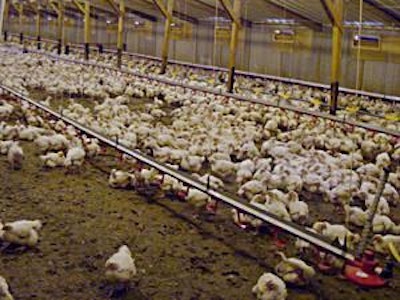
The saying “knowledge is power” may date back to the late 16th century, but it holds as true today as it ever did. In the modern world, where poultry farmers have to comply with every-increasing demands from consumers and a heavier regulatory burden, every additional insight can make a big difference.
Close to the UK town of Ipswich, Cobb Europe is growing that knowledge base. A short drive from the Suffolk town, the company operates poultry houses where birds are reared for slaughter under strictly commercial conditions but where many factors including live weight, and feed intake are carefully measured, allowing the company to understand how different management regimes influence performance.
With new EU welfare regulations around the corner, understanding better how these new requirements will work on the ground should give farmers a head start, and the benefit of the Cobb site is that conditions are as they would be in the field - with birds kept in typical housing and reared under a standard commercial contract.
Real life
The research unit operates across seven houses, divided into two sites, one with three houses the other with four. At any one time it may house some 52,000 birds.
The houses are some seven or eight years old and follow a modern design, although are not large compared to some modern broiler houses. The ventilation system is roof based, with wall mounted fans for use in warmer weather.
Birds run free within the houses with access to feeding and drinking lines. The feeding pan height is adjusted once or twice a week while water nipples are adjusted every other day. Bedding comprises shavings.
Recent work at the site has included looking at the impact of stocking densities on performance.
A comparison was made between “normal” stocking density and stocking at 20% fewer birds per square meter as under a UK welfare scheme.
Cobb 700 chicks were brought in from Holland at one day old and fed a commercially available feed, with females going to slaughter at 35 days and males at 49 days.
Over the life of the bird, a weekly weight measurement was taken and compared with target. Additionally, feed was weighed, and mortality recorded.
Real world
The advantage of the approach taken at the site is that, unlike a research trial site, birds are grown in large, whole-house groups rather than in the 20-bird pens used for standard scientific tests. Bird behavior, particularly feeding, therefore, is as it would be in any other commercial practice, giving farmers information that is easily understandable and applicable to their own situation.
Cobb regional marketing manager Euan Meldrum, points out that the work done at the farm reinforces Cobb’s recommendations, but also puts them to the test.
“With a lower stocking density,” he continues, “there may be improved litter, but what is the cost between houses? Feed costs may be lower, but fixed costs remain the same.”
There’s also the fact that lower stocking density tends to be associated with higher welfare and premium product.
The unit is the only one of its kind operated by Cobb in Europe, and the information that is coming out of it will become all the more important once poultry producers start operating under the new welfare rules.
The site is used for testing a number of variables, with the programme set a year in advance. Other work this year has included examining various feed rations, and different nutrient densities.
Once birds have gone to processing, the houses are left empty for a week, washed and disinfected, and then restocked. New birds to be reared and sold arrive and the process of building up knowledge starts all over again.

















